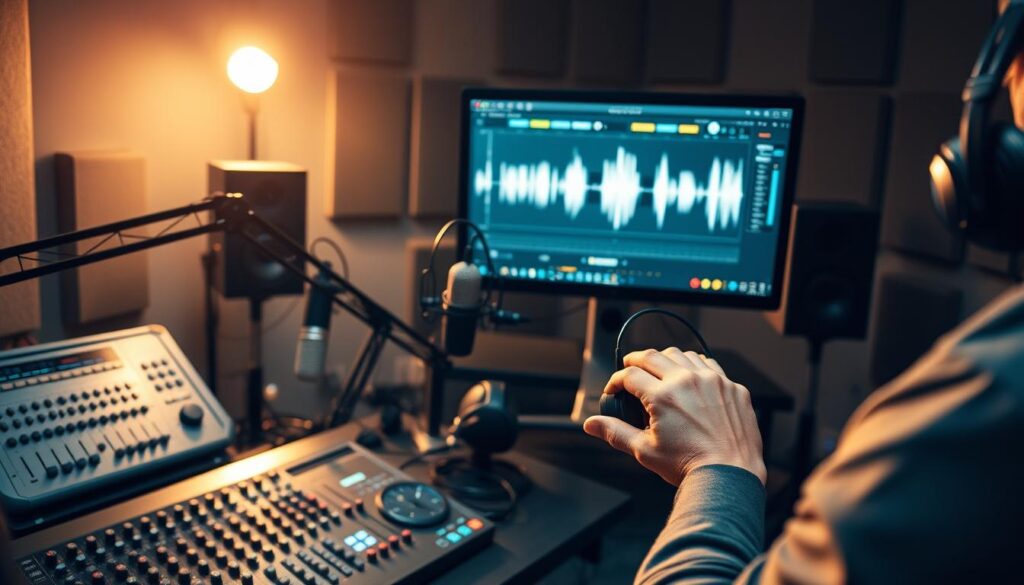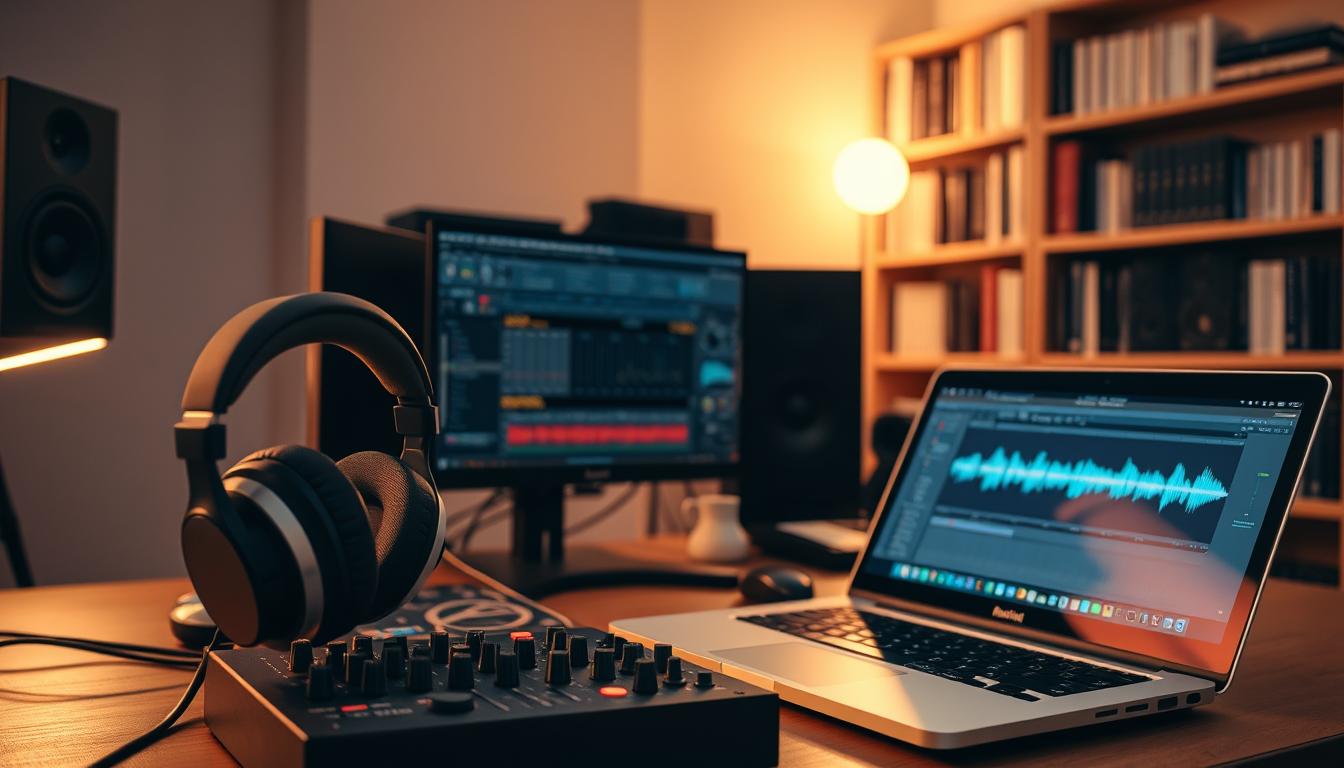Welcome to my guide on podcast editing. Here, I’ll cover the basics and what you need to get started. You’ll learn about the equipment, software, and techniques for top-notch audio.
I aim to give you the tools to improve your podcast. This is true whether you’re new to editing or have experience.
My goal is to show you why podcast editing matters. It’s key to making your podcast sound great.
Key Takeaways
- Learn the basics of podcast editing and its significance in producing high-quality audio.
- Discover the essential equipment and software needed for podcast editing.
- Understand the techniques required to produce professional-quality audio through podcast editing.
- Improve your podcast’s overall quality with effective podcast editing techniques.
- Enhance your podcast editing skills with tips and tricks from my guide.
Understanding the Basics of Podcast Editing
Podcast editing is key to making your audio sound great. It involves checking, fixing, and perfecting the sound. You need to pay close attention, be patient, and know how to edit audio well.
Clear and crisp audio is vital in podcast editing. You can get this by recording well, reducing noise, and using editing software. Good editing makes a big difference in how people listen to your podcast. We’ll look at the basics of editing and why it’s important.
- Proper levels and a well-balanced mix
- Clear and crisp audio
- Effective use of music and sound effects
Learning these basics helps you make a podcast that keeps listeners interested. Whether you’re new or experienced, knowing how to edit is crucial for a professional-sounding podcast.
We’ll dive into the world of podcast editing soon. We’ll talk about the role of audio editing software and techniques. From reducing noise to mixing and mastering, we’ll cover the key skills. By the end, you’ll know the basics of podcast editing and be ready to improve your podcast.
Essential Equipment for Podcast Editing
To start editing your podcast, you’ll need a few key pieces of equipment. A computer is a must, as it will be the central hub for your editing process. You’ll also need best editing software to bring your podcast to life. Some popular options include Audacity, Adobe Audition, and Logic Pro X. When choosing the best editing software for your needs, consider factors such as user interface, features, and compatibility with your computer.
In addition to a computer and editing software, a pair of good-quality headphones is essential for podcast editing. Look for headphones with flat frequency response and comfortable design. Other equipment you may need includes a microphone, pop filter, and acoustic treatment for your recording space.
- Computer: MacBook or Windows PC
- Best editing software: Audacity, Adobe Audition, or Logic Pro X
- Headphones: Sony MDR-7506 or Audio-Technica M50x
- Microphone: Blue Yeti or Rode NT-USB
By investing in the right equipment, you’ll be able to produce high-quality podcasts that engage and inform your audience. Remember to choose the best editing software that fits your needs and skill level. Don’t be afraid to experiment with different equipment to find what works best for you.
Choosing the Right Podcast Editing Software
Choosing the right audio editing software is key to a great podcast. With many options, picking the best can be tough. I’ve tried several and found that user interface, compatibility, and support are crucial.
Let’s look at some free software for beginners. Audacity, GarageBand, and Ocenaudio are good choices. They may not have all the bells and whistles, but they can still help you edit well.
If you’re ready to invest, there are top-notch options. Adobe Audition, Pro Tools, and Logic Pro X are favorites. They offer advanced features like multi-track editing and effects.
- Look for software with a user-friendly interface
- Consider compatibility with your operating system and hardware
- Check for customer support and online resources
By focusing on these factors, you can find the right audio editing software. This will help you create top-notch episodes that captivate your audience.
Setting Up Your Editing Workspace
Having a dedicated workspace is key for podcast editing. It boosts your efficiency and creativity. I’ll share tips on optimizing your computer, software, and hardware for editing. Also, the benefits of a quiet space and good headphones.
Here are the must-haves for your editing space:
- A quiet and distraction-free room with minimal background noise
- A comfortable and ergonomic chair and desk setup
- A reliable computer with enough power and storage for editing
- A good pair of headphones for accurate audio monitoring
Investing in these elements helps you focus on the creative parts of editing. This includes refining audio and adding music and effects. A well-set-up workspace is essential for quality podcast editing.
When setting up your space, aim for efficiency and effectiveness. This way, you can create engaging podcasts that inspire your audience. That’s the heart of podcast editing.
Fundamental Podcast Editing Techniques
Exploring podcast editing, I’ve learned that mastering certain skills is key. I’ll share essential techniques, from cleaning audio to adding music. These skills are crucial for any editor, and I’m excited to share them with you.
In audio editing, detail matters a lot. Cleaning audio files is a good starting point. It helps get rid of unwanted noise. Then, I focus on removing background noise, which can be tough but doable with the right tools. Managing audio levels is also important to keep your podcast sounding professional.
- Cleaning audio files to remove noise and distractions
- Removing background noise to improve sound quality
- Managing audio levels to ensure a professional sound
- Adding music and effects to enhance the listening experience
These techniques have elevated my podcast. I’m sure they can do the same for you. By learning these basics, you’ll be on your way to creating a top-notch podcast that captivates your audience.
Common Audio Problems and Their Solutions
As a podcast editor, I’ve seen my share of audio issues. Even with top-notch gear and software, problems can pop up. In podcast editing, knowing how to spot and fix common problems is key. This ensures your podcast sounds professional and polished.
Common audio problems include audio levels, noise, and distortion issues. To solve these, I suggest checking your recording equipment and software settings. Here are some tips to help you:
- Check your audio levels to ensure they’re not too high or too low
- Use noise reduction tools to minimize background noise
- Adjust your EQ settings to reduce distortion
In podcast editing, being meticulous and detail-oriented is crucial. By following these tips and honing your editing skills, you can make a podcast that sounds great and keeps listeners engaged.

Remember, podcast editing is an art that needs patience, practice, and attention to detail. By staying calm and methodically tackling common audio problems, you can make a podcast that resonates with your audience.
Advanced Podcast Editing Tips and Tricks
As I dive deeper into podcast editing, I’ve learned that improving my skills is key. With the basics down, I’m now exploring advanced techniques. These will help take my podcast to the next level. I’ll share tips on working with multiple tracks, smooth transitions, and mastering for different platforms.
Using the best editing software is crucial for high-quality sound. These tools help me work efficiently with multiple tracks. This ensures each part of my podcast, from music to sound effects, is perfectly balanced.
Some key considerations for advanced podcast editing include:
- Working with multiple tracks to create complex, layered soundscapes
- Creating smooth transitions between segments to maintain a cohesive flow
- Mastering for different platforms, such as Apple Podcasts or Spotify, to ensure optimal sound quality
By mastering these advanced techniques and using the best editing software, I can refine my podcast editing skills. This way, I can produce a professional-sounding podcast that resonates with my audience. Whether I’m working with multiple tracks or creating smooth transitions, the right tools are essential.
Time-Saving Workflow Strategies
As I dive into podcast editing, I’ve learned how crucial it is to make my workflow faster. Creating templates for my audio editing projects has been a game-changer. It helps me keep all episodes consistent and saves time on repetitive tasks.
Using keyboard shortcuts has also boosted my productivity. By remembering shortcuts for tasks like cutting and copying, I can work faster. For instance, Ctrl + S saves my work often, which is great for avoiding losses.
Streamlining Your Workflow
- Creating templates for consistent episode formatting
- Using keyboard shortcuts to speed up editing tasks
- Batch processing to apply changes to multiple files at once
These strategies have cut down my editing time and let me improve my skills. Whether it’s podcast editing or audio editing, a smooth workflow is key to quality content.
Conclusion: Taking Your Podcast to the Next Level
Mastering podcast editing is crucial for improving your show’s quality and keeping listeners interested. You’ve learned the basics and how to pick the best editing software. Now, you’re ready to make your audio content sound professional.
Now, it’s time to improve your podcast even more. Learn advanced editing tricks like working with multiple tracks and creating smooth transitions. Add creative sound effects and music to make your episodes more engaging.
Podcast editing is a continuous learning process. Keep exploring new techniques and practicing. Don’t hesitate to find more tutorials to improve your skills. With hard work and a commitment to getting better, you’ll create an amazing listening experience for your audience.
Use podcast editing to make your show even better. Happy editing, and may your podcast reach new heights!
